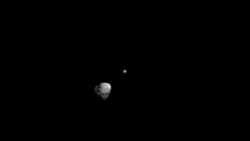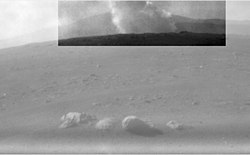


This is a list of uncrewed spacecraft which have been intentionally destroyed at their objects of study, typically by hard landings or crash landings at the end of their respective missions and/or functionality. This list only includes spacecraft specifically instructed to crash into the surface of an astronomical body other than the Earth, and also does not include unintentionally crashed spacecraft, derelict spacecraft, or spacecraft designed as landers. Intentionally crashing spacecraft not only removes the possibility of orbital space debris and planetary contamination, but also provides the opportunity (in some cases) for terminal science given that the transient light released by the kinetic energy may be available for spectroscopy; the physical ejecta can be used for further study.
Even after soft landings had been mastered, NASA used crash landings to test whether Moon craters contained ice by crashing space probes into craters and testing the debris that got thrown out. Several rocket stages utilized during the Apollo space program were intentionally crashed on the Moon to aid seismic research, and four of the ascent stages of Apollo Lunar Modules were intentionally crashed onto the Moon after they had fulfilled their primary mission. In total at least 47 NASA rocket bodies have impacted the Moon.
A recent impactor, the unusual double-crater of which was photographed on March 4, 2022 by the Lunar Reconnaissance Orbiter, is of unknown provenance; no space program has taken credit for it, although a later study attributed it to a spent upper stage from the Chang'e 5-T1 mission.
The Deep Impact mission had its own purpose-built impactor which hit Comet 9P/Tempel 1. Terminal approaches to gas giants which resulted in the destruction of the space probe count as crash landings for the purposes of this article. The crash landing sites themselves are of interest to space archeology.
Luna 1, not itself a lunar orbiter, was the first spacecraft designed as an impactor. It failed to hit the Moon in 1959, however, thus inadvertently becoming the first man-made object to leave geocentric orbit and enter a heliocentric orbit, where it remains.
Planets
Mercury
| Mission | Country/Agency | Date of landing/impact | Coordinates | Notes |
|---|---|---|---|---|
| MESSENGER | 30 April 2015 | Probably around 54.4° N, 149.9° W, near the crater Janáček | Intentionally crashed at end of mission. |
Venus
| Mission | Country/Agency | Date of landing/impact | Coordinates | Notes |
|---|---|---|---|---|
| Venera 3 | 1 March 1966 | 20°N 80°E / 20°N 80°E / 20; 80 | First manmade object to hit another planet. Failed to transmit data. | |
| Venera 4 | 18 October 1967 | 19°N 38°E / 19°N 38°E / 19; 38 | First probe to transmit data from another planet's atmosphere. Succumbed after 53 minutes, within 26 kilometres (16 mi) from the surface. | |
| Venera 5 | 16 May 1969 | 3°S 18°E / 3°S 18°E / -3; 18 | Succumbed after 51 minutes, within 26 kilometres (16 mi) from the surface. | |
| Venera 6 | 17 May 1969 | 5°S 23°E / 5°S 23°E / -5; 23 | Succumbed after 51 minutes, within 11 kilometres (6.8 mi) from the surface. | |
| Venera 7 | 15 December 1970 | 5°S 351°E / 5°S 351°E / -5; 351 | Unexpectedly survived impact and generated extremely weak signal after landing. | |
| Pioneer Venus Large probe | 9 December 1978 | 4°24′N 304°00′E / 4.4°N 304.0°E / 4.4; 304.0 | Stopped transmitting on impact with surface. | |
| Pioneer Venus Small Probe North | 9 December 1978 | 59°18′N 4°48′E / 59.3°N 4.8°E / 59.3; 4.8 | Stopped transmitting on impact with surface. | |
| Pioneer Venus Small Probe Day | 9 December 1978 | 31°18′S 317°00′E / 31.3°S 317.0°E / -31.3; 317.0 | Unexpectedly survived impact and transmitted for another 68 minutes. | |
| Pioneer Venus Small Probe Night | 9 December 1978 | 28°42′S 56°42′E / 28.7°S 56.7°E / -28.7; 56.7 | Unexpectedly survived impact and transmitted for another 2 seconds. | |
| Pioneer Venus Multiprobe Bus | 9 December 1978 | Stopped transmitting within 110 kilometres (68 mi) from the surface. | ||
| Pioneer Venus Orbiter | 22 October 1992 | intentionally held to lower orbit to facilitate orbital decay. | ||
| Magellan | 13 October 1994 | Controlled entry into Venus upon conclusion of mission. |
- Venera 8-14 and Vega 1 and 2 were explicitly designed to land on Venus and are not included in this list.
Mars
| Mission | Country/Agency | Date of landing/impact | Coordinates | Notes |
|---|---|---|---|---|
| Mars Science Laboratory Sky crane | 6 August 2012 | Bradbury Landing 4°35′09″N 137°25′52″E / 4.5859°N 137.4312°E / 4.5859; 137.4312 |
Debris field created by the heat shield, sky crane, and other components. | |
| Mars 2020 Sky crane | 18 February 2021 | Octavia E. Butler Landing 18°27′11″N 77°27′01″E / 18.453°N 77.4504°E / 18.453; 77.4504 |
Debris field created by the heat shield, sky crane, and other components. |
Jupiter
| Mission | Country/Agency | Date of landing/impact | Coordinates | Notes |
|---|---|---|---|---|
| Galileo atmospheric probe | 7 December 1995 | Functioned for 57.6 minutes, disintegrated in the Jovian atmosphere | ||
| Galileo | 21 September 2003 | Disintegrated in the Jovian atmosphere. |
Saturn
| Mission | Country/Agency | Date of landing/impact | Coordinates | Notes |
|---|---|---|---|---|
| Cassini orbiter | 15 September 2017 | 9.4° N, 53° W | 30 seconds of terminal data, more than anticipated, were received prior to Cassini's disintegration in Saturn's atmosphere. |
Planetary moons
Earth's Moon
Further information: Moon landings and List of artificial objects on the Moon
| Mission | Country/Agency | Date of landing/impact | Coordinates | Notes |
|---|---|---|---|---|
| Luna 2 | 13 September 1959 | 29°06′N 0°00′E / 29.1°N -0°E / 29.1; -0 | Intentional hard impact. | |
| Ranger 4 | 26 April 1962 | 15°30′S 130°42′W / 15.5°S 130.7°W / -15.5; -130.7 | Intentional hard impact; hit lunar far side due to failure of navigation system. | |
| Ranger 6 | 2 February 1964 | 9°24′N 21°30′E / 9.4°N 21.5°E / 9.4; 21.5 | Intentional hard impact. | |
| Ranger 7 | 31 July 1964 | 10°21′S 20°35′W / 10.35°S 20.58°W / -10.35; -20.58 | Intentional hard impact. | |
| Ranger 8 | 20 February 1965 | 2°43′N 24°37′E / 2.72°N 24.61°E / 2.72; 24.61 | Intentional hard impact. | |
| Ranger 9 | 24 March 1965 | 12°50′S 2°22′W / 12.83°S 2.37°W / -12.83; -2.37 | Intentional hard impact. | |
| Lunar Orbiter 1 | 29 October 1966 | 6°21′N 160°43′E / 6.35°N 160.72°E / 6.35; 160.72 | Lunar orbiter, intentionally crashed at end of mission. | |
| Hiten | 10 April 1993 | 34°18′S 55°36′E / 34.3°S 55.6°E / -34.3; 55.6 | Lunar orbiter, intentionally crashed at end of mission. | |
| Lunar Prospector | 31 July 1999 | 87°42′S 42°06′E / 87.7°S 42.1°E / -87.7; 42.1 | Lunar orbiter, intentionally crashed into polar crater at end of mission to test for liberation of water vapour (not detected). | |
| SMART-1 | 3 September 2006 | 34°15′43″S 46°11′35″W / 34.262°S 46.193°W / -34.262; -46.193 | Lunar orbiter, intentionally crashed at end of mission. | |
| Chandrayaan-1 Moon Impact Probe | 14 November 2008 | 89°46′S 39°24′W / 89.76°S 39.40°W / -89.76; -39.40 | Impactor. Water found. | |
| SELENE Rstar (Okina) | 12 February 2009 | Lunar orbiter, intentionally crashed at end of mission. | ||
| Chang'e 1 | 1 March 2009 | 1°30′S 52°22′E / 1.50°S 52.36°E / -1.50; 52.36 | Lunar orbiter, intentionally crashed at end of mission. | |
| Kaguya | 10 June 2009 | Lunar orbiter, intentionally crashed at end of mission. | ||
| LCROSS (Centaur) | 9 October 2009 | 84°40′30″S 48°43′30″W / 84.675°S 48.725°W / -84.675; -48.725 84°43′44″S 49°21′36″W / 84.729°S 49.360°W / -84.729; -49.360 |
Impactors: main craft flew through the plume of lunar dust created by its own upper rocket stage gathering data. Water confirmed. | |
| Longjiang 2 | 31 July 2019 | 16°41′44″N 159°31′01″E / 16.6956°N 159.5170°E / 16.6956; 159.5170 | Micro-satellite, intentionally crashed at end of mission. | |
| Chang'e 5 ascender | 7 December 2020 | 30°S 0°E / 30°S 0°E / -30; 0 | Intentional impact of ascent stage after delivering sample to orbiter. | |
| Chang'e 6 ascender | 6 June 2024 | Intentional impact of ascent stage after delivering sample to orbiter. |
Other bodies
Asteroids
| Mission | Country/Agency | Date of landing/impact | Coordinates | Notes |
|---|---|---|---|---|
| NEAR Shoemaker | 12 February 2001 | Eros | Slow impact with asteroid surface, spacecraft operated for another two weeks on asteroid surface. | |
| Hayabusa 2 Small Carry-On Impactor (SCI) | 5 April 2019 | Ryugu | Copper projectile shot at surface with explosive charge to expose asteroid subsurface. | |
| Double Asteroid Redirection Test (DART) | 26 September 2022 | Dimorphos | First attempt in history to redirect an asteroid. |
Comets
| Mission | Country/Agency | Date of landing/impact | Coordinates | Notes |
|---|---|---|---|---|
| Deep Impact | 4 July 2005 | Tempel 1 | The "Smart Impactor" had a payload of 100 kg of copper, which at its closing velocity of 10.2 km/s had the kinetic energy equivalent to 4.8 tonnes of TNT. | |
| Rosetta | 30 September 2016 | 67P/Churyumov–Gerasimenko | Intentionally crashed at end of mission. |
Chronological gallery
-
 Ranger 4
Ranger 4
-
Ranger 6
-
 Rangers 7, 8, and 9
Rangers 7, 8, and 9
-
 Lunar Orbiter 1
Lunar Orbiter 1
-
 Hiten
Hiten
-
 Galileo Probe
Galileo Probe
-
 Galileo
Galileo
-
 Lunar Prospector
Lunar Prospector
-
 Deep Impact
Deep Impact
-
 SMART-1
SMART-1
-
 Chandrayaan-1
Chandrayaan-1
-
 SELENE (Kaguya)/Okina
SELENE (Kaguya)/Okina
-
 Chang'e 1
Chang'e 1
-
 LCROSS
LCROSS
-
 MESSENGER
MESSENGER
-
 Mars Science Laboratory
Mars Science Laboratory
-
 Cassini
Cassini
-
 Mars 2020
Mars 2020
See also
- List of extraterrestrial orbiters
- List of landings on extraterrestrial bodies
- List of artificial objects on extraterrestrial surfaces
- Flyby (spaceflight)
- Space rendezvous
References
- "Crash Landing on the Moon". NASA Science. Archived from the original on April 16, 2010. Retrieved April 20, 2016.
- Chron, Ariana Garcia (June 29, 2022). "'Mystery rocket' that crashed into the Moon baffles NASA scientists". Chron.
- Wall, Mike (16 November 2023). "Rogue rocket that slammed into the moon last year confirmed to be Chinese vehicle". Space.com. Future US Inc. Retrieved 28 February 2024.
- Robinson, Mark (November 14, 2019). "Longjiang-2 Impact Site Found!".
| Exploration of the Solar System | |||||
|---|---|---|---|---|---|
| Exploration of | |||||
| Artificial objects |
| ||||
| Lists | |||||
| Spaceflight lists and timelines | |||||||||||||||||
|---|---|---|---|---|---|---|---|---|---|---|---|---|---|---|---|---|---|
| General | |||||||||||||||||
| Human spaceflight |
| ||||||||||||||||
| Solar System exploration | |||||||||||||||||
| Earth-orbiting satellites | |||||||||||||||||
| Vehicles | |||||||||||||||||
| Launches by rocket type |
| ||||||||||||||||
| Launches by spaceport | |||||||||||||||||
| Agencies, companies and facilities | |||||||||||||||||
| Other mission lists and timelines | |||||||||||||||||